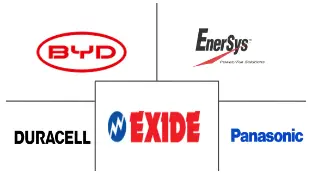Plug-in Hybrid Electric Vehicle Battery Market Size and Share
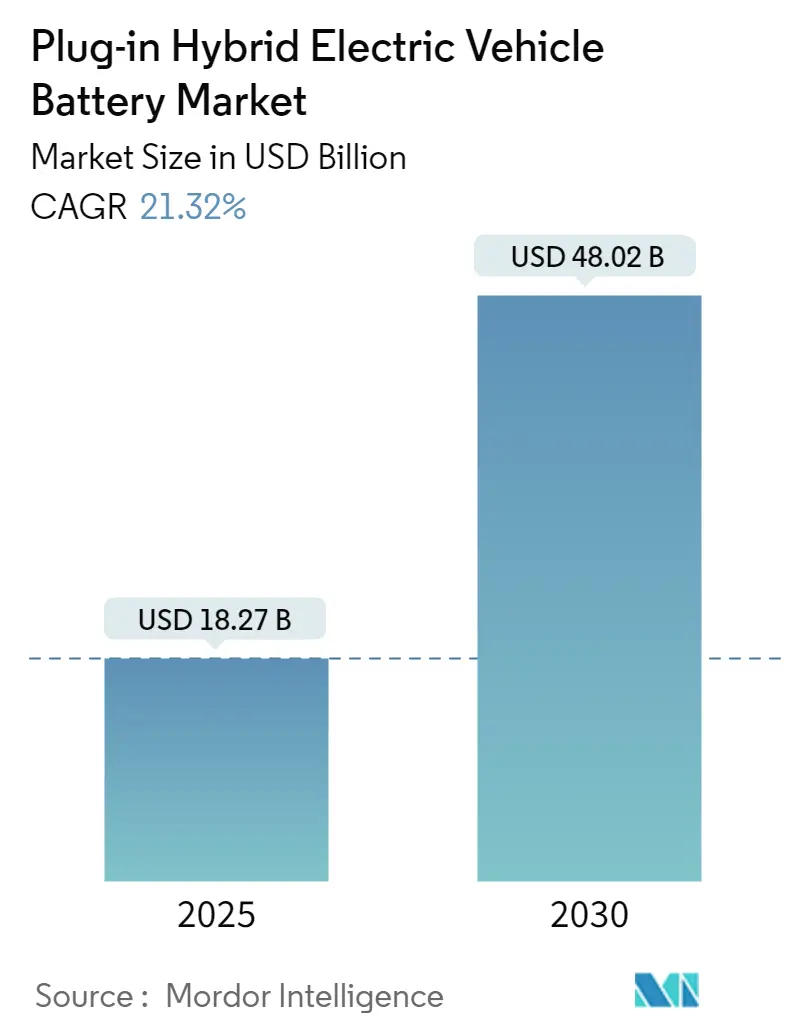
Plug-in Hybrid Electric Vehicle Battery Market Analysis by Mordor Intelligence
The Plug-in Hybrid Electric Vehicle Battery Market size is estimated at USD 18.27 billion in 2025, and is expected to reach USD 48.02 billion by 2030, at a CAGR of 21.32% during the forecast period (2025-2030).
- Over the medium term, rising adoption of electric vehicles (EV) and declining lithium-ion battery prices are expected to drive the demand for plug-in hybrid electric vehicle batteries during the forecast period.
- On the other hand, the lack of raw material reserves can significantly restrain the growth of the plug-in hybrid electric vehicle battery market.
- Nevertheless, technological advancements in battery materials like higher energy density, faster charging times, improved safety, and longer lifespan are expected to create significant opportunities for plug-in hybrid electric vehicle battery market players in the near future.
- Europe is the fastest-growing region in the global plug-in hybrid electric vehicle battery market during the forecast period due to the rising adoption of electric vehicles.
Global Plug-in Hybrid Electric Vehicle Battery Market Trends and Insights
Lithium-Ion Battery Type Dominate the Market
- The lithium-ion electric vehicle battery market worldwide presents a fascinating landscape of opportunities and challenges. Due to their favorable capacity-to-weight ratio, lithium-ion rechargeable batteries are gaining more popularity than other battery technologies. Factors contributing to their increased adoption include enhanced performance (such as longer lifespan and lower maintenance requirements), extended shelf life, and decreasing prices. The price of lithium-ion batteries is usually higher than that of other batteries. However, major players across the market have been investing to gain economies of scale and R&D activities to enhance their performance, increasing the competition and, in turn, resulting in declining prices of lithium-ion batteries.
- Owing to the increasing average battery pack prices of electric vehicles (EV) and battery energy storage systems (BESS), the battery prices declined in 2023 to USD 139 /kWh, a decrease of over 13%. The trajectory of technological innovation and manufacturing enhancements is anticipated to decrease the battery pack prices further, projecting the price to reach USD 113/kWh in 2025 and USD 80/kWh in 2030.
- Furthermore, governments worldwide are significantly promoting electric vehicles due to rising environmental concerns. The government is significantly focused on net zero carbon emission targets. The demand for electric vehicles is significant across the globe, and companies are investing heavily to fulfill the rising demand for EVs.
- For instance, in March 2024, Hyundai announced it is likely to invest more than USD 50 billion in South Korea by 2026, with a considerable investment dedicated to boosting the development and production of electric vehicles across the country. The company aims to boost electric car production to more than 3.6 million units by 2030. Such initiatives are likely to raise the demand for late EVs across the country in the coming years and increase the demand for lithium-ion batteries during the forecast period.
- Additionally, the government worldwide has implemented various policies and incentives to promote electric vehicles. These policies have positively impacted the demand for lithium-ion batteries. The government announced numerous initiatives to promote EVs across the region.
- For instance, as of 2023, the Chinese government offers substantial subsidies for EV purchases, sometimes up to RMB 100,000 (USD 15,000) per vehicle. Additionally, EV buyers benefit from exemptions from the vehicle purchase tax, which can be a significant cost-saving opportunity for Chinese consumers. Such initiatives are likely to accelerate the production and demand of EVs across the country in the coming years and are likely to raise the demand for lithium-ion batteries in the forecast period.
- Such types of projects and investments are likely to increase EV production across the region, and there will be a rising demand for lithium-ion batteries during the forecast period.
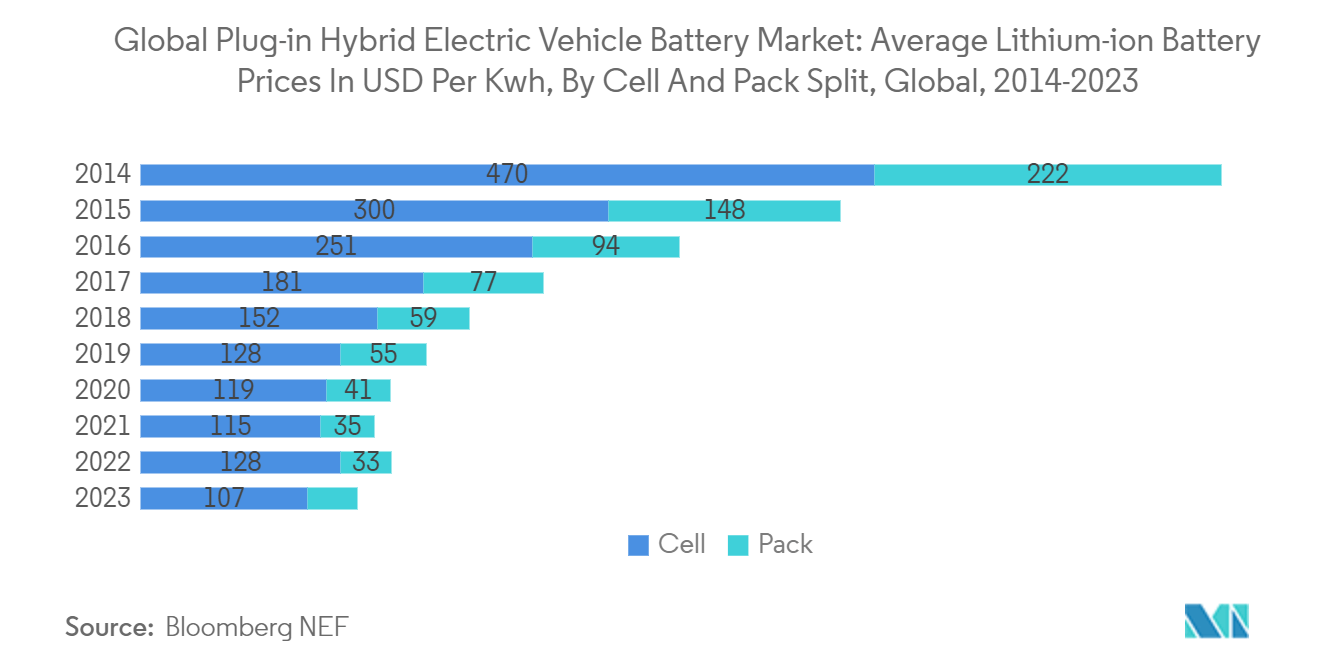
Europe to Witness Significant Growth
- The Plug-in Hybrid Electric Vehicle (PHEV) battery market in Europe is expanding rapidly, driven by a combination of regulatory support, technological advancements, and increasing consumer demand for sustainable transportation solutions. The growth is fueled by government initiatives promoting battery production, the thriving EV industry, and the presence of numerous battery manufacturers in the region.
- The European region, including countries like Germany, the United Kingdom, and Sweden, is experiencing significant growth in the PHEV battery market. This is due to rising demand for eco-friendly vehicles and a robust governmental push toward reducing carbon emissions.
- The demand for plug-in hybrid electric vehicles (PHEV) is rising significantly across the region. Germany is the region's leading producer of PHEV. For instance, according to the International Energy Agency (IEA), in 2023, the sale of Plug-in Hybrid Electric Vehicles in Germany was 0.18 million units, followed by the United Kingdom and Japan with 0.14 million units. EV Sales are rising in the coming years as numerous EV production plants are set up across the European region, and the demand for plug-in hybrid electric vehicle (PHEV) batteries is increasing.
- Governments in the region are implementing various policies and incentives to promote the adoption of plug-in hybrid and electric vehicles. These include subsidies, tax benefits, and stringent emission norms which encourage manufacturers to produce more PHEVs.
- For instance, as of 2023, the government of Norway announced the adjustment of taxation for electric cars and plug-in hybrid cars used as company vehicles. Employers who provide employees with electric cars can deduct DKK 15,000 (USD 2,150) from the tax base from 2023 to 2026. This deduction applies to all zero-emission cars, supporting the uptake of EVs across the region. Such initiatives are likely to accelerate the production and demand of EVs across the country in the coming years and are likely to raise the demand for PHEV batteries during the forecast period.
- Moreover, the expansion of charging infrastructure across Europe makes PHEVs a more viable option for consumers. This infrastructure development, combined with advancements in battery technology and governmental support, positions the European market as a pivotal player in the global shift toward sustainable and electrified transportation. The government launched several initiatives to raise public charging points across the country in the coming years.
- For instance, in October 2023, the French government announced that it is likely to pour EUR 200 million (USD 216 million) into charging stations for electric cars. The government set a target of 400,000 public charging terminals by 2030. The 200 million euro package is intended to support the development of fast-charging stations and installations in public and commercial premises. Such initiatives and targets are likely to raise public charging points and surge the demand for PHEV batteries during the forecast period across the region.
- Such project developments showcase the feasibility and importance of PHEV battery solutions for battery energy storage systems in EVs and are likely to raise the demand for PHEV batteries across the country in the coming year.
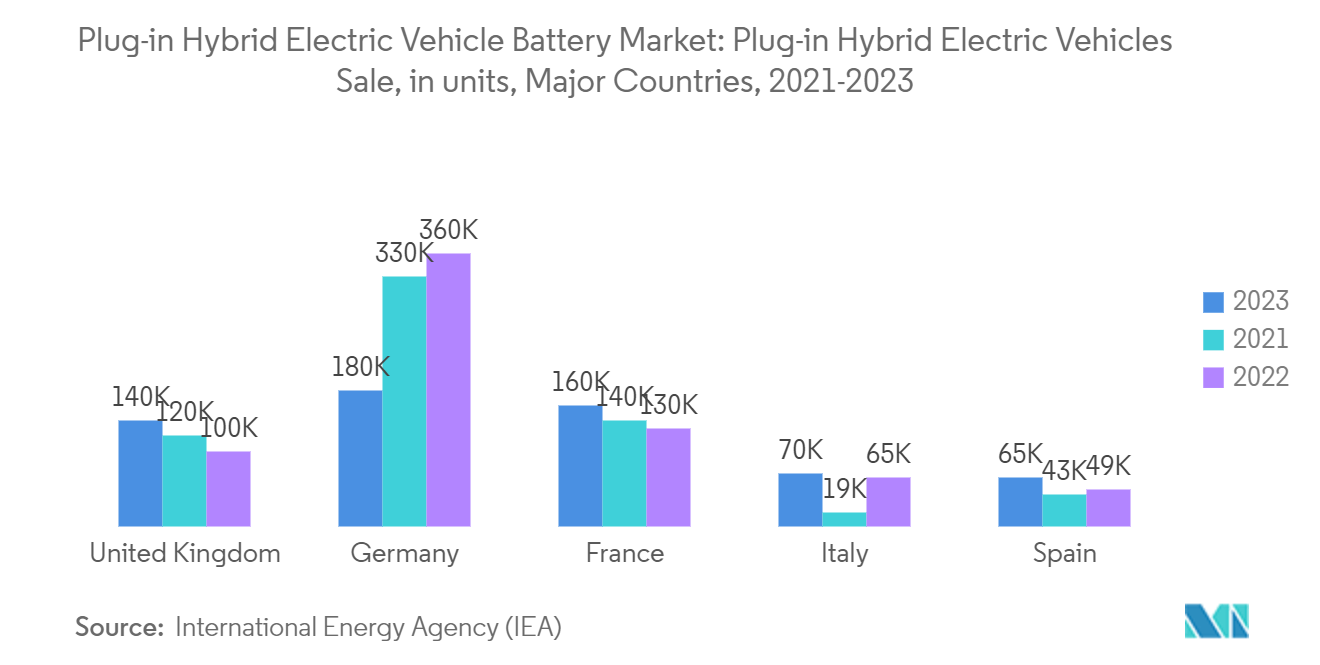
Competitive Landscape
The plug-in hybrid electric vehicle battery market is semi-fragmented. Some key players (not in particular order) are BYD Company Ltd, Duracell Inc., Exide Industries Ltd, EnerSys, and Panasonic Holdings Corporation, among others.
Plug-in Hybrid Electric Vehicle Battery Industry Leaders
Panasonic Holdings Corporation
EnerSys
Duracell Inc.
Exide Industries Ltd
BYD Company Ltd
- *Disclaimer: Major Players sorted in no particular order
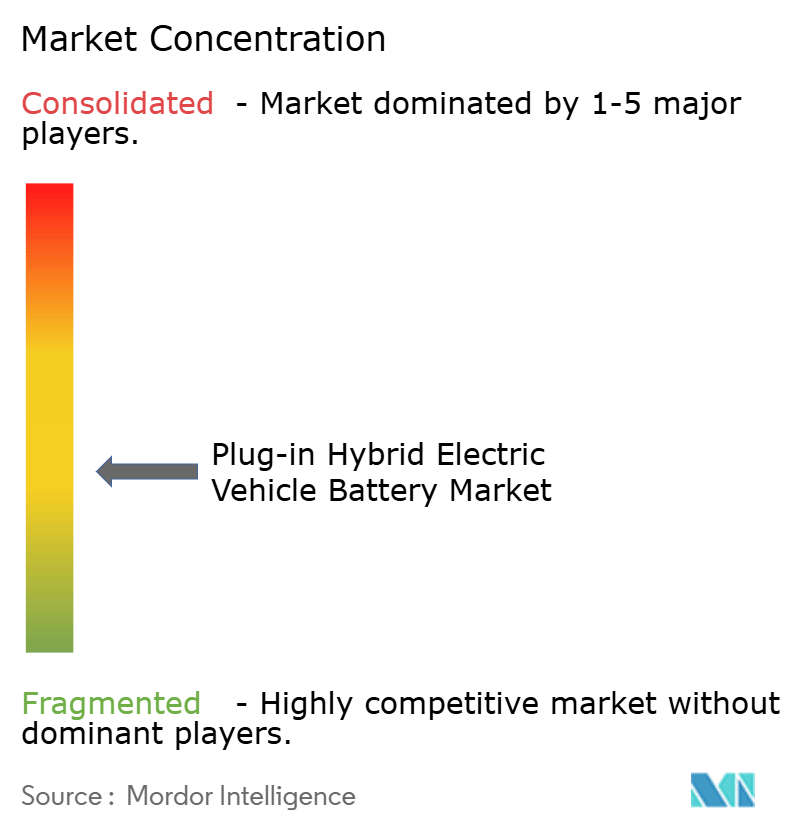
Recent Industry Developments
- March 2024: LeydenJar, a Dutch battery manufacturer and developer, announced that it is going to open its first battery production factory in Eindhoven, the Netherlands. The company expects to begin production in 2026 as it continues to create the world’s most energy-dense battery.
- February 2024: ReElement Technologies made a memorandum of understanding with Afrivolt to support the development of Africa’s regional and global lithium-ion battery supply chains. As per the agreement, both companies will work together to establish a comprehensive closed-loop lithium battery and electric vehicle manufacturing ecosystem within Africa.
Global Plug-in Hybrid Electric Vehicle Battery Market Report Scope
The battery of a plug-in hybrid electric (PHEV) vehicle is a rechargeable energy storage system that provides power to its electric motor. Unlike standard hybrid electric vehicles (HEVs), PHEVs can be plugged into an external electric power source to charge their batteries, allowing for extended electric-only driving range.
The global plug-in hybrid electric vehicle battery market is segmented by battery type (lithium-ion batteries, lead-acid batteries, sodium-ion batteries, and battery types), vehicle type (passenger cars and commercial vehicles), and geography (North America (United States, Canada, and Rest of North America), Europe (Germany, France, United Kingdom, Italy, Spain, Nordic, Russia, Turkey, Rest of Europe), Asia-Pacific (China, India, Australia, Japan, South Korea, Malaysia, Thailand, Indonesia, Vietnam, Rest of Asia-Pacific), the Middle East and Africa (Saudi Arabia, United Arab Emirates, Nigeria, Egypt, Qatar, South Africa, and Rest of the Middle East and Africa), and South America (Brazil, Argentina, Colombia, and Rest of South America)). The report also covers the market size and forecasts for the global plug-in hybrid electric vehicle battery market across major regions. the report offers the market size and forecasts in revenue (USD) for all of the above.
| Lithium-ion Battery |
| Lead-Acid Battery |
| Sodium-ion Battery |
| Other Battery Types |
| Passenger Cars |
| Commercial Vehicles |
| North America | United States |
| Canada | |
| Rest of North America | |
| Europe | Germany |
| France | |
| United Kingdom | |
| Italy | |
| Spain | |
| NORDIC | |
| Russia | |
| Turkey | |
| Rest of Europe | |
| Asia-Pacific | China |
| India | |
| Australia | |
| Japan | |
| South Korea | |
| Malaysia | |
| Thailand | |
| Indonesia | |
| Vietnam | |
| Rest of Asia-Pacific | |
| Middle East and Africa | Saudi Arabia |
| United Arab Emirates | |
| Nigeria | |
| Egypt | |
| Qatar | |
| South Africa | |
| Rest of Middle East and Africa | |
| South America | Brazil |
| Argentina | |
| Colombia | |
| Rest of South America |
| Battery Type | Lithium-ion Battery | |
| Lead-Acid Battery | ||
| Sodium-ion Battery | ||
| Other Battery Types | ||
| Vehicle Type | Passenger Cars | |
| Commercial Vehicles | ||
| Geography [Market Size and Demand Forecast till 2029 (for regions only)] | North America | United States |
| Canada | ||
| Rest of North America | ||
| Europe | Germany | |
| France | ||
| United Kingdom | ||
| Italy | ||
| Spain | ||
| NORDIC | ||
| Russia | ||
| Turkey | ||
| Rest of Europe | ||
| Asia-Pacific | China | |
| India | ||
| Australia | ||
| Japan | ||
| South Korea | ||
| Malaysia | ||
| Thailand | ||
| Indonesia | ||
| Vietnam | ||
| Rest of Asia-Pacific | ||
| Middle East and Africa | Saudi Arabia | |
| United Arab Emirates | ||
| Nigeria | ||
| Egypt | ||
| Qatar | ||
| South Africa | ||
| Rest of Middle East and Africa | ||
| South America | Brazil | |
| Argentina | ||
| Colombia | ||
| Rest of South America | ||
Key Questions Answered in the Report
How big is the Plug-in Hybrid Electric Vehicle Battery Market?
The Plug-in Hybrid Electric Vehicle Battery Market size is expected to reach USD 18.27 billion in 2025 and grow at a CAGR of 21.32% to reach USD 48.02 billion by 2030.
What is the current Plug-in Hybrid Electric Vehicle Battery Market size?
In 2025, the Plug-in Hybrid Electric Vehicle Battery Market size is expected to reach USD 18.27 billion.
Who are the key players in Plug-in Hybrid Electric Vehicle Battery Market?
Panasonic Holdings Corporation, EnerSys, Duracell Inc., Exide Industries Ltd and BYD Company Ltd are the major companies operating in the Plug-in Hybrid Electric Vehicle Battery Market.
Which is the fastest growing region in Plug-in Hybrid Electric Vehicle Battery Market?
Europe is estimated to grow at the highest CAGR over the forecast period (2025-2030).
Which region has the biggest share in Plug-in Hybrid Electric Vehicle Battery Market?
In 2025, the Asia Pacific accounts for the largest market share in Plug-in Hybrid Electric Vehicle Battery Market.
What years does this Plug-in Hybrid Electric Vehicle Battery Market cover, and what was the market size in 2024?
In 2024, the Plug-in Hybrid Electric Vehicle Battery Market size was estimated at USD 14.37 billion. The report covers the Plug-in Hybrid Electric Vehicle Battery Market historical market size for years: 2019, 2020, 2021, 2022, 2023 and 2024. The report also forecasts the Plug-in Hybrid Electric Vehicle Battery Market size for years: 2025, 2026, 2027, 2028, 2029 and 2030.
Page last updated on:
Plug-in Hybrid Electric Vehicle Battery Market Report
Statistics for the 2025 Plug-in Hybrid Electric Vehicle Battery market share, size and revenue growth rate, created by Mordor Intelligence™ Industry Reports. Plug-in Hybrid Electric Vehicle Battery analysis includes a market forecast outlook for 2025 to 2030 and historical overview. Get a sample of this industry analysis as a free report PDF download.
